May 12 - 18, 2013: Issue 110
Royal Navy and Royal Australian Navy Ships Visit Pittwater and Broken Bay –
Training Days, Fleet Exercises and the Love of the Navy
The fear that was expressed so often prior to the turn of the century (1900) seemed to abate slightly with Federation and the construction of an Australian Naval fleet both here and in purchasing UK constructed vessels. The Boxer Revolution in China (1900-1901) saw reservist Australian Naval patrols organised to guard the coasts and ent to China in August 1900. Much of the rest of our Servicemen were at the Boer War.
Pittwater has always been a mooring place for just about every vessel in the Royal Navy and then the Royal Australian Navy fleet for training exercises within her waters and in the waters offshore at Broken Bay. Torch, H.M.S., left Sydney on Monday for Broken Bay. SHIPPING. (1898, December 21). The Brisbane Courier (Qld. : 1864 - 1933), p. 3. Retrieved from http://nla.gov.au/nla.news-article3684763
This was not as noisy as may seem at first as most of the ordnance used in these exercises and training were not fitted to go ‘boom’! Although there are a few instances of torpedoes running amuck and running themselves into shale or sand, no one was injured and the practice served to identify how to make these missiles go where you want them to go when that is what is required. The only real explosion occurred offshore when an old vessel was used for target practice.
A list of many of the naval vessels that visited Pittwater has been collected below as well as some of what they did while here. Apart from training hard there were also opportunities to experience the beauty of the area and the also maritime focused pursuits of the local people. In fact, so many of our fleets, past and present, have visited Pittwater that Governor Phillip's proclamation of the estuary and its surrounds being large enough to, ‘contain all the Navy ships..’ seemed to be words worth making come true;
FIRST ENTRY TO PITTWATER. On the same day-March 3, 1788- Phillip's party crossed Broken Bay, and he recorded that "Immediately round the headland that forms the southern entrance Into the bay there is a branch, which I think the finest piece of water I ever saw, and which I honoured with the name of Pitt Water. It is, as well as the south-west branch, of sufficient extent to contain all the navy of Great Britain, but has only eighteen feet at low water on a narrow bar which runs across the entrance." PITTWATER. (1929, September 28). The Sydney Morning Herald (NSW : 1842 - 1954), p. 13. Retrieved from http://nla.gov.au/nla.news-article16588226
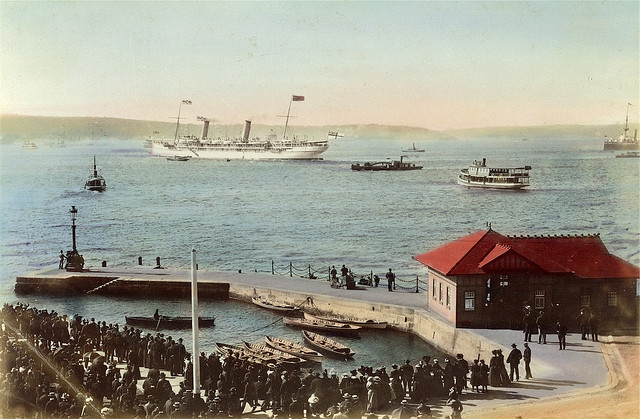 One of the
first of the naval vessels to visit after the powder hulk was
moved was in connection with a Royal visit by their Royal Highnesses the Duke
and Duchess of Cornwall and York (later King George V and Queen Mary). The
Duke's main task while in Australia was to inaugurate the first Australian
Federal Parliament in Melbourne;
One of the
first of the naval vessels to visit after the powder hulk was
moved was in connection with a Royal visit by their Royal Highnesses the Duke
and Duchess of Cornwall and York (later King George V and Queen Mary). The
Duke's main task while in Australia was to inaugurate the first Australian
Federal Parliament in Melbourne;
THE LANDING IN SYDNEY. Upon their return from Brisbane southward the Duke and Duchess of Cornwall and York will only remain at Newcastle for a few minutes. It has been arranged that the Ophir, probably accompanied by H.M.S. St. George and H.M.S. Juno, will proceed to Broken Bay, where the Royal visitors will leave the train, at the Hawkesbury Bridge, and embark on the Royal yacht. This arrangement will permit the programme drawn up in connection with the reception and landing at Farm Cove to be carried out as originally outlined. The new N.S.W. Government yatch Sohemara is to take a party of members of Parliament to the Hawkesbury to welcome the Royal guests. THE LANDING IN SYDNEY. (1901, May 21). Bathurst Free Press and Mining Journal (NSW : 1851 - 1904), p. 2. Retrieved from http://nla.gov.au/nla.news-article64453811
Above: A crowd watches as the Duke and Duchess of Cornwall and York leave on the H.M.S. Ophir for Auckland - Sydney, New South Wales, 9 June 1901, courtesy Museum of Australian Democracy Collection. Inscription on the reverse of photo reads: "Departure of Ophir with Duke and Duchess".
The 'Ophir', a British steel twin-screw ocean liner owned by the Orient Steamship Co. of London, restyled HMS Ophir in 1901, conveyed the Duke and Duchess of Cornwall and York (the future King George V and Queen Mary) on their tour of the British Empire. She was anchored in Cowan Creek while the Royal couple boarded the paddle wheel steam boat the 'General Gordon' for a tour of the lower Hawkesbury;
The Royal train, with the Duke and Duchess of
Cornwall and York and suite on board will probably pass through Muswellbrook
about 9 o'clock this (Saturday) morning. The Royal party are due at Newcastle at
noon, where they will join in a procession from Hamilton to Newcastle railway
station. They will afterwards proceed to the Hawkesbury River and embark on the
S. S. General Gordon, which will convey them to the
Royal Yacht Ophir, anchored off Cowan Bay,
whence they will proceed to Sydney on Monday morning. The Royal Train.
(1901, May 25. Saturday). The Muswellbrook
Chronicle(NSW : 1898 - 1955), p. 2. Retrieved from http://nla.gov.au/nla.news-article107003732

Duke and Duchess leave Hawkesbury for Sydney aboard the General Gorodn - Hawkesbury, New South Wales, 25 May 1901, Museum of Australian Democracy Collection also a black and white sepia version: Pic. No. a116435. Courtesy State Library of NSW
There has always been a strong connection to the Navy in Pittwater, a respect for what can be learnt from all admiralty practices in safety and utilising smaller vessels for ‘mosquito fleets’ and naval auxiliary vessels in times of conflict. Yachts don’t need fuel when war rations cannot afford them; they need breeze only. Cruisers can access creeks and bays where breeze may not be available.
Almost every vessel in the Royal Navy and all classes of vessels in the Royal Australian Navy, have sailed, steamed and dived here at Pittwater and in the waters of Broken Bay. Part of this respect for Naval people stems from the sacrifice of those who serve and those who wait at home for them during the long voyages undertaken. There has always been, and still is, a large fan base for Naval personnel whether an admiral, commodore, captain or regular seaman and women. Just how esteemed they were in some ports they visited is evidenced in this report:
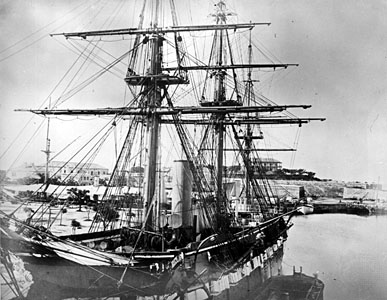 THE
FOLLIES OF FASHION. - It is stated that a mania has taken fast hold of
Wellington ladies which would be highly flattering to the officers of
H.M.S. Challenger (right) if they
were not too well accustomed to that sort of thing. We refer to the fashion of
ladies assimilating their dress as much as possible to that of the naval
officers, and of wear-ing in their hair and as ornaments to their dresses,
anchors, brass buttons, gold bands, marlings, pikes blocks, &c. to such a
pitch has this mania for naval "belongings" reached, that not a ball takes place
in Wellington now at which at least half a dozen young ladies may not be seen
with their chignons tied on the tops of their heads with black ribbons, on which
the word Challenger stands out conspicuous in gold letters in front. This seems
ticketing themselves with a vengeance, and in a way happily not often seen among
English girls. In the day time, as well as in the evening, the naval influence
is observable. Take a stroll down the beach and ten to one the first lady you
meet will have on a blue pilot jacket, ornamented with brass buttons, and with
gold bands round the wrists. These latter are intended to make her neighbours as
wise as herself as to the rank of her naval sweetheart, of her own brevet.
The Sydney Morning Herald. (1869, September 7). The
Sydney Morning Herald (NSW : 1842 - 1954), p. 4. Retrieved from http://nla.gov.au/nla.news-article13178785
THE
FOLLIES OF FASHION. - It is stated that a mania has taken fast hold of
Wellington ladies which would be highly flattering to the officers of
H.M.S. Challenger (right) if they
were not too well accustomed to that sort of thing. We refer to the fashion of
ladies assimilating their dress as much as possible to that of the naval
officers, and of wear-ing in their hair and as ornaments to their dresses,
anchors, brass buttons, gold bands, marlings, pikes blocks, &c. to such a
pitch has this mania for naval "belongings" reached, that not a ball takes place
in Wellington now at which at least half a dozen young ladies may not be seen
with their chignons tied on the tops of their heads with black ribbons, on which
the word Challenger stands out conspicuous in gold letters in front. This seems
ticketing themselves with a vengeance, and in a way happily not often seen among
English girls. In the day time, as well as in the evening, the naval influence
is observable. Take a stroll down the beach and ten to one the first lady you
meet will have on a blue pilot jacket, ornamented with brass buttons, and with
gold bands round the wrists. These latter are intended to make her neighbours as
wise as herself as to the rank of her naval sweetheart, of her own brevet.
The Sydney Morning Herald. (1869, September 7). The
Sydney Morning Herald (NSW : 1842 - 1954), p. 4. Retrieved from http://nla.gov.au/nla.news-article13178785
H.M.S. Challenger, Commander Lambert, arrived on Saturday from Broken Bay, and when steaming up the harbour was saluted by the guns of H.M.S. Charybdis. The compliment was returned soon afterwards. SHIPS' MAILS. (1867, November 18). Empire (Sydney, NSW : 1850 - 1875), p. 4. Retrieved from http://nla.gov.au/nla.news-article60847232
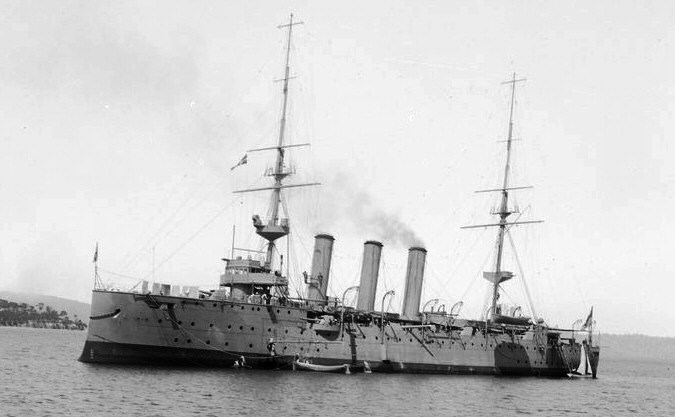 This is
not the HMS Challenger that visited Broken Bay in 1905 as part of
annual naval training exercises. Pictured at left, this HMS Challenger was a
second-class protected cruiser of the Challenger class of the Royal
Navy.
This is
not the HMS Challenger that visited Broken Bay in 1905 as part of
annual naval training exercises. Pictured at left, this HMS Challenger was a
second-class protected cruiser of the Challenger class of the Royal
Navy.
Commissioned on 30 May 1904, she commenced duty on the Australia Station (the British—and later Australian—naval command responsible for the waters around the Australian continent). She was paid off into reserve on 10 October 1912 before recommissioning during the First World War.
H.M.S. Euryalus, first-class twin-screw armoured cruiser, flagship on the Australian Station, 12,000 tons displacement, 39 guns, and four torpedo cubes, Captain Charles L. Napier, from Broken Bay. H.M.S. Challenger, second-class twin-screw protected cruiser, 5800 tons displacement, 31 guns, Captain Frederick C. T. Tudor, from Broken Bay. SHIPPING. (1905, October 27). The Sydney Morning Herald(NSW : 1842 - 1954), p. 6. Retrieved from http://nla.gov.au/nla.news-article14733644
A prevailing caution to percieved agressors, despite many of these nations vessels visiting our ports and even carrying our mails, may have been added impetus to send naval vessels to train in our waters:
UK WEAK DEFENCES. TO THE EDITOR OF THE HERALD. Sir,-The warning given by Admiral Fanshave in reference to "the vulnerability of our coast" is one that our Federal administrators should take serious note of, for the seething condition of Russia, the peculiar tactics of the German Emperor, the restless nature of the French, the disturbances in the Balkans and other storm centres, and the critical state of affairs in China, Japan, and Manchuria, may at any moment bring on a war in which Great Britain may be engaged. The question of defence is therefore the most urgent that can engage the attention of the Federal Parliament and the Federal administrators. ..
Broken Bay, which is the side door for Sydney, seems to have been neglected altogether in the matter of batteries; and there is, therefore, nothing on the shores of that bay and its inlets of Cowan and Pittwater to prevent ships from steaming within a few yards of the shore and disembarking thousands of soldiers. We may be told that the hills about Cowan are so steep that a small force could easily beat back an army from them. So thought Montcairn at Quebec, but Wolfe's army clambered on to the Heights of Abraham and defeated him there. At all events, thousands of troops could be landed at Pittwater or near tho Hawkesbury railway station, from both of which positions they could fight their way to a commanding position on North Sydney, practically in the roar of our forts and batteries. Our submarines are supposed to be in good order, but it would be wise, nevertheless, to have more definite information on that point. OUR WEAK DEFENCES. (1905, June 10). The Sydney Morning Herald (NSW : 1842 - 1954), p. 14. Retrieved from http://nla.gov.au/nla.news-article14709090
A succession of vessels are reported training naval personnel or conducting inter-vessel exercises. Sometimes these ran for a day, sometimes overnight and sometimes for up to three weeks.
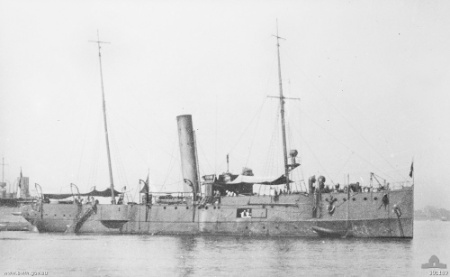 NEWCASTLE.
NEWCASTLE NAVAL BRIGADE. NEWCASTLE, Monday. The Newcastle detachment (G Company)
of the Naval Brigade, under Commander Gardner, left by the afternoon train
today for Hawkesbury, where they will join the gun-boat Protector and undergo
their annual training at sea. The Protector was originally
coming to Newcastle, but owing to the stress of weather she put into
Broken Bay, and as economy in the consumption of coal is a matter which
has to be considered, it was arranged that the men should proceed to Broken Bay.
Forty-five men have taken advantage of the training, and Commander Gardner has
associated with him Staff-Surgeon Nixon, Sub-Lieutenant G. Dick, and Acting
Sub-Lieutenant O. Gillam. The Protector will go to sea to-night, and during the
six days' training some useful long-distance firing will be carried out.
NEWCASTLE. (1907, March 19). The Sydney Morning
Herald(NSW : 1842 - 1954), p. 6. Retrieved from http://nla.gov.au/nla.news-article14834386
NEWCASTLE.
NEWCASTLE NAVAL BRIGADE. NEWCASTLE, Monday. The Newcastle detachment (G Company)
of the Naval Brigade, under Commander Gardner, left by the afternoon train
today for Hawkesbury, where they will join the gun-boat Protector and undergo
their annual training at sea. The Protector was originally
coming to Newcastle, but owing to the stress of weather she put into
Broken Bay, and as economy in the consumption of coal is a matter which
has to be considered, it was arranged that the men should proceed to Broken Bay.
Forty-five men have taken advantage of the training, and Commander Gardner has
associated with him Staff-Surgeon Nixon, Sub-Lieutenant G. Dick, and Acting
Sub-Lieutenant O. Gillam. The Protector will go to sea to-night, and during the
six days' training some useful long-distance firing will be carried out.
NEWCASTLE. (1907, March 19). The Sydney Morning
Herald(NSW : 1842 - 1954), p. 6. Retrieved from http://nla.gov.au/nla.news-article14834386
THE PROTECTOR'S CRUISE. The South Australian gunboat Protector, which is on a visit to Sydney in connection with the annual training of the N.S.W, section of the Australian naval forces, left port at 6.50 a.m. yesterday with the first batch of men, and arrived at Broken Bay at 8.30 a.m. THE PROTECTOR'S CRUISE. (1909, January 21). The Sydney Morning Herald (NSW : 1842 - 1954), p. 8. Retrieved from http://nla.gov.au/nla.news-article15030331
During WWI there was some naval activity on Pittwater, as both a practice and precautionary measure:
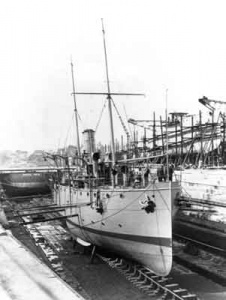 MINE-SWEEPING
PRACTICE. The Department of Navigation notifies masters of vessels
trading to Broken Bay and the Hawkesbury River and all persons in charge
of vessels navigating the waters of Broken Bay, Hawkesbury River and Pittwater,
that mine-sweeping practice is to be carried out from to day at the entrance to
Broken Bay and in Pittwater. This work will be performed by
HMAS Gayundah and Defence Department’s s.s. Miner. These
vessels will work together, connected by a wire hawser and will show a black
ball at their foremast head and a similar ball at the yard arm (or where it can
best be seen) on that side on which it is dangerous for vessels to pass. All
other vessels must keep out of the way of vessels showing these signals, and
must not attempt to pass between them. It is further proposed to lay
dummy mines in a buoyed area to the northward of fairway and outside Elliot
Island. MINE-SWEEPING PRACTICE. (1915, February
12). The Sydney Morning Herald (NSW : 1842 - 1954), p. 7.
Retrieved from http://nla.gov.au/nla.news-article15550578 Picture to right:
Gayundah receiving her new bow in 1914, courtesy R.A.N. history pages.
MINE-SWEEPING
PRACTICE. The Department of Navigation notifies masters of vessels
trading to Broken Bay and the Hawkesbury River and all persons in charge
of vessels navigating the waters of Broken Bay, Hawkesbury River and Pittwater,
that mine-sweeping practice is to be carried out from to day at the entrance to
Broken Bay and in Pittwater. This work will be performed by
HMAS Gayundah and Defence Department’s s.s. Miner. These
vessels will work together, connected by a wire hawser and will show a black
ball at their foremast head and a similar ball at the yard arm (or where it can
best be seen) on that side on which it is dangerous for vessels to pass. All
other vessels must keep out of the way of vessels showing these signals, and
must not attempt to pass between them. It is further proposed to lay
dummy mines in a buoyed area to the northward of fairway and outside Elliot
Island. MINE-SWEEPING PRACTICE. (1915, February
12). The Sydney Morning Herald (NSW : 1842 - 1954), p. 7.
Retrieved from http://nla.gov.au/nla.news-article15550578 Picture to right:
Gayundah receiving her new bow in 1914, courtesy R.A.N. history pages.
H M A.S. Melbourne, for Broken Bay. DEPARTURES.—May 5. (1920, May 6). The Sydney Morning Herald (NSW : 1842 - 1954), p. 8. Retrieved from http://nla.gov.au/nla.news-article15888572
MINE-SWEEPING PRACTICE. Sydney, August 7. H.M.A.S. Marguerite, with the Mallow proceeded to Broken Bay today. Where they will carry out mine-sweeping exercises. MINE-SWEEPING PRACTICE. (1923, August 8). The Advertiser(Adelaide, SA : 1889 - 1931), p. 12. Retrieved from http://nla.gov.au/nla.news-article37196702
H.M.A.S. Marguerite is due back In Sydney today from Broken Bay, where she has been engaged on training cruise with naval reserves aboard for the past fortnight. The Marguerite is expected to arrive at 3 p.m., and will proceed to an anchorage at Garden island. H.M.A.S. MARGUERITE DUE TO-DAY. (1925, November 11).The Sydney Morning Herald (NSW : 1842 - 1954), p. 17. Retrieved from http://nla.gov.au/nla.news-article16254284
Arrivals - H.M.A.S. Anzac, destroyer, from Broken Bay, 8.42 a.m. H.M.A.S. Success, destroyer, from Broken Bay, 8.14 .m. H.M.A.S. Swordsman, destroyer, from Broken Bay,S.S 9.05a.m. SHIPPING. (1928, April 21). The Sydney Morning Herald (NSW : 1842 - 1954), p. 21. Retrieved from http://nla.gov.au/nla.news-article16458720
DEPARTURES.-April 29. H.M.A.S. Geranium, for Broken Bay, 3.27 p.m. DEPARTURES.—April 29. (1927, April 30). The Sydney Morning Herald (NSW : 1842 - 1954), p. 18. Retrieved from http://nla.gov.au/nla.news-article28056010
Departures– November 3.– HMAS Sydney for Broken Bay. 10.15am. DEPARTURES.—Nov. 3. (1927, November 4). The Sydney Morning Herald (NSW : 1842 - 1954), p. 17. Retrieved from http://nla.gov.au/nla.news-article16416235
H.M.A.S. MELBOURNE. H.M.A.S. Melbourne, the new flagship of the Australian fleet, is to leave Sydney at 3 o'clock this afternoon, and for the next week will be carrying out naval exercises near Broken Bay., This cruiser will return to Sydney on, November 4. H.M.A.S. MELBOURNE. (1927, October 27). The Sydney Morning Herald (NSW : 1842 - 1954), p. 12. Retrieved from http://nla.gov.au/nla.news-article16414807
NAVAL AND MILITARY News and Notes The Survey Ships. H.M.S. Moresby, which left Sydney on April 19 for Broken Bay (N.S.W.), remained there for about a month surveying near Pittwater, after which she returned to Sydney, and is now surveying on the Queensland coast. NAVAL AND MILITARY. (1927, June 1). The Mercury (Hobart, Tas. : 1860 - 1954), p. 9. Retrieved from http://nla.gov.au/nla.news-article29674978
THE NAVY. Two Ships to Pay Off. MOMBAH TO BE SOLD. It is the intention of the Navy Department to pay off almost immediately the destroyer Swordsman, and to sell the coal lighter Momball, now in Sydney Harbour. H.M.A.S, Moresby, which is due at Sydney tomorrow from Brisbane, is also to be laid up. For several years the Moresby has been surveying on the Queensland coast, and has done much valuable work there in locating hidden shoals. During the present cruise, which began in April, she made several startling discoveries of dangerous reefs in the track of shipping. It was explained last night that the Moresby was financed under a special trust fund, which is now exhausted. The Swordsman was paid off this year, but was recommissioned to carry out special torpedo duties at Pittwater. It is probable that before being placed in E class reserve, where she will be ready for sea with 14 days' notice, she will be sent to Newcastle to represent the Navy at the civic week celebrations, beginning on December 14. With the Swordsman out of commission the destroyer flotilla will be reduced to the Anzac and Success. The Mombah was built at Cockatoo in 1920 and is of no value to the navy now that all the ships are oil-fired. THE NAVY. (1929, December 9). The Sydney Morning Herald(NSW : 1842 - 1954), p. 11. Retrieved from http://nla.gov.au/nla.news-article16608336
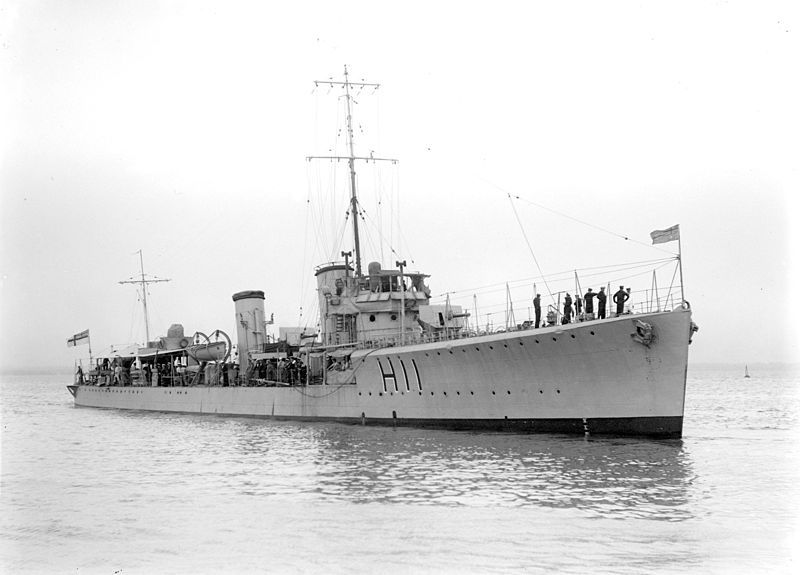
HMAS Swordsman, by Allan C. Green 1878 - 1954, courtesy State Library of Victoria.
TORPEDO TESTS. SWORDSMAN AT PITTWATER. For the first time within the memory of State navigation officials, torpedo tests will be carried out at Pittwater commencing September 9, and continuing until further notice. Between 8 a.m. and noon and 1 p.m. to 4p.m. daily except Saturdays and Sundays, the destroyer Swordsman will fire torpedoes in a northerly direction. While the torpedo practice is in progress vessels are warned against going south of Observation Head and north of the destroyer. A special signal will be exhibited at Barrenjoey Lighthouse. Further exercises were carried out of Sydney Heads yesterday by the submarines Otway and Oxley, and the destroyer-leader Anzac. TORPEDO TESTS. (1929, August 30). The Sydney Morning Herald (NSW : 1842 - 1954), p. 10. Retrieved from http://nla.gov.au/nla.news-article16579607
TORPEDO PRACTICE. FISHERMAN
STARTLED. Three fishermen had a thrilling experience at Pittwater on
Wednesday afternoon, when an 18ft Whitehead torpedo sped past their launch and
burled its 5-sad In the sand nearby. Harold Holloway was with
his two companions-Charles Mace and Bill Williams overhauling
the engine of their launch, which was moored close to inner Palm
Beach. Suddenly he heard a hissing noise, and saw a long grey
object speed past and run in on the sand. Although the torpedo
contained no explosive, had it struck the side of the launch, which it
missed by only a few feet, it would probably have crushed the side of the boat.
The reaches near Pittwater are periodically utilised by the Australian
navy for torpedo practice, and on this occasion the torpedo was fired
by H.M.A.S. Swordsman, more than a mile away. Later the torpedo was recovered by
a party from the destroyer, who towed it back to their ship.
NAVY
DEPARTMENT'S VIEW.
The fact that torpedoes fired by the destroyer Swordsman
in Pittwater sometimes behave erratically is not taken seriously by the Navy
Department. It was explained yesterday that after being overhauled at Garden
Island the torpedoes are subjected to the most rigorous tests before being
issued to the commissioned ships of the fleet. That each torpedo is worth£2500
is a sufficient explanation. "The Intention of sending the Swordsman to
Pittwater is to find out any defects and remedy them," said an officer
yesterday. "The fact that one or two torpedoes behave strangely rather
justifies our investigations. These are carried out on the same lines as those
adopted at the Royal Navy's testing station in Scotland."
The
Federal Navigation Department draws attention to the warning that shipping
should not come within certain limits In Pittwater while the tests are in
progress. Signals are exhibited at Barrenjoey Lighthouse and by the Swordsman.
TORPEDO PRACTICE. (1929, September 20).
The Sydney Morning Herald (NSW : 1842 - 1954), p. 12. Retrieved from http://nla.gov.au/nla.news-article16585813
TORPEDO TESTS. As H.M.A.S. Swordsman will be engaged in other duties, torpedo tests will not take place next week in Pittwater. Officers at Garden Island were concerned yesterday lest a published statement, when read in conjunction with the report of a torpedo having gone ashore, should imply that the safety of people was not considered with due seriousness. TORPEDO TESTS. (1929, September 21). The Sydney Morning Herald (NSW : 1842 - 1954), p. 16. Retrieved from http://nla.gov.au/nla.news-article16586225
The destroyer Swordsman left port yesterday morning for Pittwater, where she will carry out torpedo exercises. On December 14 she will proceed to Newcastle for the Civic Week celebrations. THE FLEET. (1929, December 10). The Sydney Morning Herald (NSW : 1842 - 1954), p. 10. Retrieved from http://nla.gov.au/nla.news-article16608647
.jpg?timestamp=1368276205734) HMS
Torrens (right), a River-class torpedo-boat destroyer named for the river in
Adelaide, utilised as target practice, signified not only the demise of a grand
vessel that had served Australia well but also indicated a scaling back of
vessels as the Depression in Australia hit home.
HMS
Torrens (right), a River-class torpedo-boat destroyer named for the river in
Adelaide, utilised as target practice, signified not only the demise of a grand
vessel that had served Australia well but also indicated a scaling back of
vessels as the Depression in Australia hit home.
FLEET MANOEUVRES. Torrens Used as Target.'ENGAGEMENT' OFF COAST. (From our Special Representative, on board H.M.A.S. Canberra.) Steaming at 20 knots to "engage an enemy destroyer" 14 miles east of Broken Bay shortly after noon yesterday, H.M.A.S. Canberra had fired two broadsides from her four twin eight-inch gun turrets, when a "superior enemy force" made Its appearance on the horizon. Turning off to avoid the trap thus set for her, the Canberra continued the engagement whilst retiring, In accordance with previous instructions, on the main body of the Australian fleet, which lay on the disengaged bow. The flagship H.M.A.S. Australia, then entered the battle, and was successful in driving off the attack.
This was the Illusion which made it easier to settle the fate of the obsolete destroyer Torrens. For the few laymen who were privileged to witness the manoeuvre from the deck of the Canberra, interest in the exercise and admiration for the skill and accuracy of the Australian gunners were subordinated to some extent to sorrow at the passing of the famous old craft. Built at Cockatoo Island dockyard early in 1916 as one of the units of the first Australian destroyer flotilla, the Torrens served throughout the war, rendering valuable service. Stripped of most of her superstructure, she was a sorry enough sight yesterday. Managing to preserve some of her proud lines, however, she seemed loath to go to her doom. FLEET MANOEUVRES. (1930, April 10). The Sydney Morning Herald (NSW : 1842 - 1954), p. 9. Retrieved from http://nla.gov.au/nla.news-article16684068
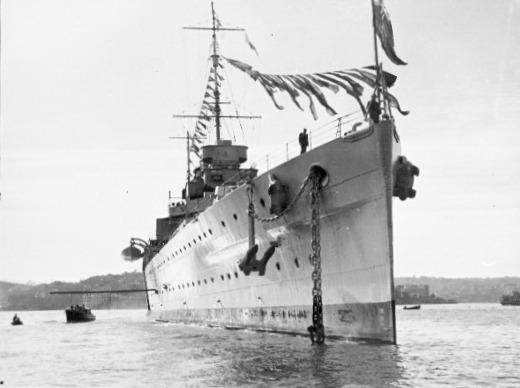 Left: HMAS Australia
Left: HMAS Australia
The Depression in Australia, which some sources state had its worst year in 1933, then created a resurgance in 'waste not want not' attitude that was extended to our naval ships, reversing a post WWI decommissioning;
TORPEDO PRACTICE. The destroyer HMAS. Tattoo which has been held in immediate reserve for several months, was recommissioned yesterday for a short period and on Tuesday next she will proceed to Pittwater in order to carry out torpedo practice. Shipping is warned that torpedo firing practice will take place in Pittwater commencing on October 10 and continuing daily, with the exception of Saturdays and Sundays until October 27. The torpedoes will be fired between 8am and noon and 1pm and 4pm from the Tattoo, which will be anchored near Taylor's Point, in a northerly direction from Observatory Point. Vessels are warned not to proceed south of Observation Head or north of the destroyer when red flag signals are being flown by the destroyer and a motor launch in the vicinity of Rock Head. THE FLEET. (1933, October 6). The Sydney Morning Herald (NSW : 1842 - 1954), p. 10. Retrieved from http://nla.gov.au/nla.news-article17012902
"MOULDIES." WHAT TORPEDOES DO. EVERYTHING BUT
TALK. (BY OUR SPECIAL REPRESENTATIVE ON BOARD HMAS TATTOO ) BROKEN BAY,
Tuesday.
Torpedoes are costly things. In a naval engagement a destroyer
throws away thousands of pounds every time she looses her death-dealing
projectiles into the sea. In times of peace, however, they are adjusted to float
after concluding their dash through several miles of water, and are used so
often that those charged with their guardianship come to regard them with
something like affection, almost as personal friends.
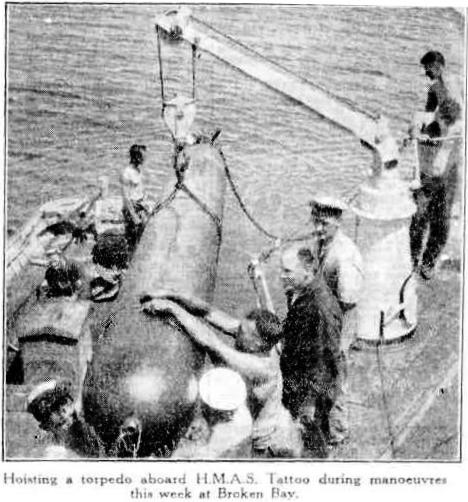 Sailors
not directly, connected with torpedoes are inclined to refer to these self
propelling shells somewhat contemptuously as "fish." Torpedo men, on the other
hand, have sentimentally called them "mouldies," a name which apparently has no
more meaning than most nick-names, and reply to the sarcasm of their rivals, the
gunners, with the retort that torpedoes are "fish" that do almost everything but
talk. A really keen torpedo man can tell you the history of every projectile In
his ship. On such and such a day OX9 misbehaved herself, ran off her
course, and tried conclusions with a stretch of shingle beach. She
could not lie about it, however, because a self recording chart in her stern
recorded every minute of her escapade. PZ10, on the other hand, has always been
noted for her regularity of habits, sober-minded attention to duty, and fixity
of purpose. OX9 is being disciplined, and may soon become as exemplary as PZ10,
which has really no reason to be so proud of her-self.
Sailors
not directly, connected with torpedoes are inclined to refer to these self
propelling shells somewhat contemptuously as "fish." Torpedo men, on the other
hand, have sentimentally called them "mouldies," a name which apparently has no
more meaning than most nick-names, and reply to the sarcasm of their rivals, the
gunners, with the retort that torpedoes are "fish" that do almost everything but
talk. A really keen torpedo man can tell you the history of every projectile In
his ship. On such and such a day OX9 misbehaved herself, ran off her
course, and tried conclusions with a stretch of shingle beach. She
could not lie about it, however, because a self recording chart in her stern
recorded every minute of her escapade. PZ10, on the other hand, has always been
noted for her regularity of habits, sober-minded attention to duty, and fixity
of purpose. OX9 is being disciplined, and may soon become as exemplary as PZ10,
which has really no reason to be so proud of her-self.
NO FUSS ABOUT IT.
When an 8-inch or 12-inch gun
sets to work it takes good care that everyone within miles knows all about it.
It flashes fire and belches smoke from its muzzle, and the shell leaves it with
a mighty roar which rocks the air. There is no such fuss about a torpedo tube.
There is a dull explosion, a whistle which rises to a subdued shriek, and a
splash of water, in which mingles a thin line of white smoke. Then one sees a
thin line of bubbles which merge into a wake of palest green in contrast to the
blue of the surrounding waters. In war that line of bubbles would end with a
mighty explosion as the torpedo struck the enemy ship at which it had been
aimed. In practice such as that carried out from the Tattoo
today, however, the war-head is replaced by a soft collision-head. The torpedo
breaks surface at the target, where it is adjusted to halt, and its position is
indicated by a thick cloud of smoke from a flame which is ignited as soon as the
projectile comes into contact with the air.
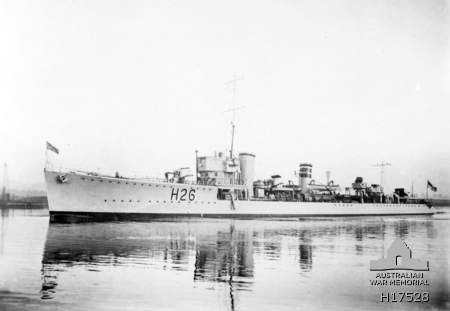 One might imagine
that, leaving a wake behind it, a torpedo would be a comparatively easy thing to
avoid. It must be remembered, however, that the projectile is rushing through
the water at the speed of an express train, and that it is always a good deal
ahead of the bubbles, which take seconds to rise from the depth at which it is
adjusted to travel. More-over, destroyers have a more interesting purpose than
last destruction. In a major engagement they play an important part in the
tactics of the commander-in-chief, who may use them and their ubiquitous "fish"
to change the direction of an enemy line if that suits his purpose. The enemy
commander often has to change line or lose some of his battleships.
One might imagine
that, leaving a wake behind it, a torpedo would be a comparatively easy thing to
avoid. It must be remembered, however, that the projectile is rushing through
the water at the speed of an express train, and that it is always a good deal
ahead of the bubbles, which take seconds to rise from the depth at which it is
adjusted to travel. More-over, destroyers have a more interesting purpose than
last destruction. In a major engagement they play an important part in the
tactics of the commander-in-chief, who may use them and their ubiquitous "fish"
to change the direction of an enemy line if that suits his purpose. The enemy
commander often has to change line or lose some of his battleships.
NAVY'S NEW LIFE. From the complement of the Tattoo (left), which was recommissioned recently to carry out extensive gunnery and torpedo manoeuvres, one gathers an impression that new hope has been put into the Royal Australian Navy by the Federal Government's recent announcement of a defence policy which is no longer one of "cut and scrape." Both officers and men feel that they have still a long way to go before the reach complete restoration of the personal prospects which existed when most of them joined the service. Nevertheless, they realise that the move is at last in the right direction, and that the navy will be gradually restored to that state of efficiency and usefulness which gained for the squadron such an enviable reputation during the war. "MOULDIES.". (1933, October 18). The Sydney Morning Herald(NSW : 1842 - 1954), p. 13. Retrieved from http://nla.gov.au/nla.news-article17016560
Above picture: TORPEDO PRACTICE AT BROKEN BAY. (1933, October 20).The Sydney Morning Herald (NSW : 1842 - 1954), p. 14. Retrieved from http://nla.gov.au/nla.news-article17017045
H.M.A.S. YARRA. The sloop Yarra, which left on Monday with the Swan for a naming cruise with members of the Royal Australian Naval Reserve, returned to port yesterday morning to unship mine-sweeping gear which had been used at Broken Bay, and pick up tackle for towing battle-practice targets. She left port again last night, and proceeded to Jervis Bav where she will take part in manoeuvres with the rest of the fleet. H.M.A.S. YARRA. (1938, March 17). The Sydney Morning Herald(NSW : 1842 - 1954), p. 5. Retrieved from http://nla.gov.au/nla.news-article17449419
NAVAL TRAINING CRUISE, HMAS Yarra, with 60 Royal Australian Naval reserve ratings from Tasmania on board returned to Sydney yesterday after a training cruise in Broken Bay. She will leave for Hobart today. NAVAL TRAINING CRUISE. (1938, November 9). The Sydney Morning Herald (NSW : 1842 - 1954), p. 16. Retrieved from http://nla.gov.au/nla.news-article17535796
World War Two emphasised how important annual naval exercises were. Pittwater, protected by the Volunteer Coastal Patrol and the Navy Auxiliary, still witnessed training exercises and vigilant patrols. A note of interets here:
MR. O. H. BEALE (Lib., Parramatta), 47, is a barrister. He has acted as counsel for the Commonwealth, in matters relating to immigration, taxation, Customs, navigation, and national security measures. He is a member of the executive of the Liberal Party. During the war, Mr. Beale served as a member of the R.A.N.V.R. with the anti-submarine patrols and commanded the Naval Auxiliary Patrol at Broken Bay. NEW MEMBERS. (1946, September 30). The Sydney Morning Herald (NSW : 1842 - 1954), p. 1. Retrieved from http://nla.gov.au/nla.news-article17996811
MID-AIR CRASH. Sea Search For Pilots. At dawn today planes and naval vessels will continue the search for two R.A.A.F. pilots who are believed to have parachuted into the sea off Shellharbour yesterday morning after their Mustang fighters had collided. An extensive air and surface search yesterday failed to reveal either pilot. The Mustangs were on a training flight from No. 78 Wing, Williamtown, Newcastle. The accident occurred while a flight of eight Mustangs was changing formation at 4,000 feet. All available Navy vessels and R.A.N. planes from H.M.A.S. Albatross, near Nowra, were ordered to the area. They included H.M.A.S. Condamine, and the British submarine Tactician, which were exercising off Jervis Bay, and H.M.A.S. Murchison, exercising off Broken Bay. MID-AIR CRASH. (1950, November 8). The Sydney Morning Herald (NSW : 1842 - 1954), p. 1. Retrieved from http://nla.gov.au/nla.news-article18185126
NAVAL MOVEMENTS SAILINGS TODAY: HMAS COWRA and HMAS COLAC, for Broken Bay, fitting-out wharf, 8 30 am. SHIPPING INFORMATION. (1952, February 15). The Sydney Morning Herald (NSW : 1842 - 1954), p. 7. Retrieved from http://nla.gov.au/nla.news-article18255812
SHIPPING ARRIVALS YESTERDAY: The Sydney
Morning Herald (NSW : 1842 - 1954) Friday 13 June 1952 p 7
Article HMAS SHOALHAVEN from Broken Bay. SHIPPING ARRIVALS YESTERDAY: The Sydney Morning
Herald (NSW : 1842 - 1954) Thursday 20 November 1952 p 8
Article NAVAL MOVEMENTS HMAS CULGOA and HMAS SHOALHAVEN, from Broken
Bay. SHIPPING INFORMATION
ARRIVALS The Sydney Morning Herald (NSW : 1842 - 1954) Friday 26
December 1952 p 5 Article NAVAL MOVEMENTS H.M.A.S. WAGGA and
H.M.A.S.COOTAMUNDRA, for Broken Bay, Garden Island, p.m. SHIPPING ARRIVALS The Sydney Morning Herald (NSW : 1842 -
1954) Friday 27 February 1953 p 6 Article NAVAL MOVEMENTS
HMAS CULGOA, from Broken Bay and exercises. SHIPPING ARRIVALS
YESTERDAY: The Sydney Morning Herald (NSW : 1842 - 1954) Friday 7 August 1953 p
8 Article NAVAL MOVEMENTS HMAS RESERVE, from Broken Bay, HMAS
COOTAMUNDRA, for Broken Bay, to morrow, p m. SHIPPING INFORMATION ARRIVALS YESTERDAY. The Sydney Morning Herald (NSW :
1842 - 1954) Thursday 13 May 1954 p .jpg?timestamp=1368277942671) 9 Article
H.M.A.S. WOOMERA, for Broken Bay . SHIPPING ARRIVALS The Sydney Morning Herald (NSW : 1842 - 1954)
Friday 4 June 1954 p 12 Article NAVAL MOVEMENTS TO-MORROW:
H.M.A.S. BATAAN, for Broken Bay, Garden Island, 8.30 a.m. SUNDAY:
H.M.A.S. BATAAN, from Broken Bay. SHIPPING ARRIVALS YESTERDAY: The Sydney Morning Herald (NSW : 1842 -
1954) Wednesday 14 July 1954 p 11 Article ... MOVEMENTS SAIL WEDNESDAY:
HMAS Hawkesbury, for Broken Bay, Garden Island, 8 15 a m ARRIVE
FRIDAY: HMAS Hawkesbury, from Broken Bay.
9 Article
H.M.A.S. WOOMERA, for Broken Bay . SHIPPING ARRIVALS The Sydney Morning Herald (NSW : 1842 - 1954)
Friday 4 June 1954 p 12 Article NAVAL MOVEMENTS TO-MORROW:
H.M.A.S. BATAAN, for Broken Bay, Garden Island, 8.30 a.m. SUNDAY:
H.M.A.S. BATAAN, from Broken Bay. SHIPPING ARRIVALS YESTERDAY: The Sydney Morning Herald (NSW : 1842 -
1954) Wednesday 14 July 1954 p 11 Article ... MOVEMENTS SAIL WEDNESDAY:
HMAS Hawkesbury, for Broken Bay, Garden Island, 8 15 a m ARRIVE
FRIDAY: HMAS Hawkesbury, from Broken Bay.
NAVAL MOVEMENTS H M S TELEMACHUS, for Broken Bay, Balmoral, tomorrow, a m. HMAS WAGGA (left) and H M N Z S HAWEA, for Broken Bay, Garden Island, to morrow, a m (FA0444). HMAS COOTAMUNDRA, for Broken Bay, Garden Island, tomorrow, p m (FA0444) SHIPPING INFORMATION. (1954, January 25). The Sydney Morning Herald (NSW : 1842 - 1954), p. 9. Retrieved from http://nla.gov.au/nla.news-article18406177
The list above indicates how many naval vessels were conducting exercises near or off Broken Bay. What this list doesn't illustrate is the reinstituting of National Service in 1951.
The intensification of the Cold War in Europe, Communist insurgency and success in South-East Asia, and the declaration of war in Korea, the Menzies government sponsored the National Service Act 1951. The legislation provided for the compulsory call-up of males turning 18 on or after 1 November 1950, for service training of 176 days. Trainees were required to remain on the Reserve of the Commonwealth Military Forces (CMF) for five years from initial call up. Men could nominate the service in which they wished to be trained. Those nominating the Navy or the Air Force were considered only if they volunteered for service outside Australia. The first call-up notice was issued on 12 April 1951. Between 1951 and 1959 over 500,000 men registered, 52 intakes were organised and some 227,000 men were trained. (2).
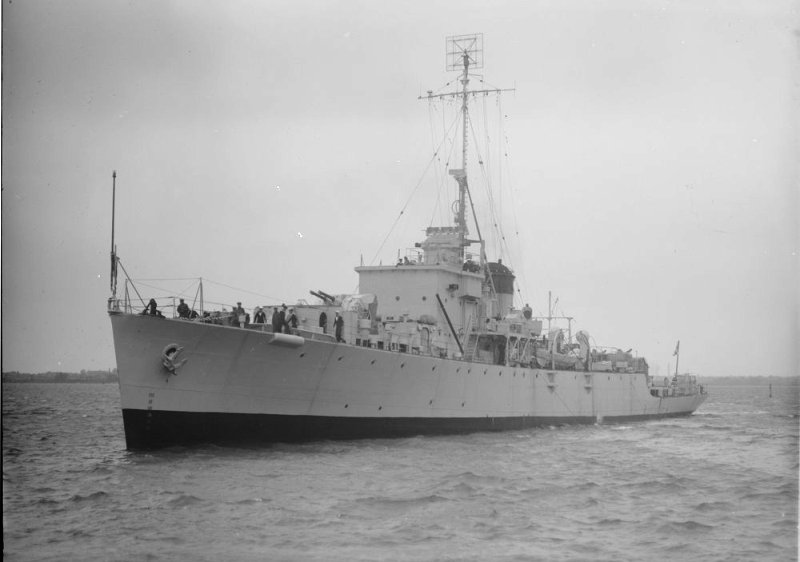
HMAS Culgoa, Image 229052, courtesy State Librray of NSW
Trainees Learn Navy's Way By A STAFF
CORRESPONDENT
HMAS Culgoa was bucking a stiff north-east
gale An 18-year-old "macker," his face turned from greenish-yellow to flat
white, appealed to Chief Petty Officer R J Bell "Please sir, put me off the ship
at Sydney I can t stand it, and I'll never be a sailor "
Bell looked stern He
said roughly, "Here, what's this? You're not on the Spirit of Progress now Stick
it out lad "
The boy was one of 80 National Service trainees in the frigate. The old hands call them Mackers because of their tremendous appetite for macaroons.
No Kid Gloves
And
whatever may be happening in the other Services the Navy is not handling its
trainees with kid gloves Officially they are treated exactly the same as
ordinary RAN recruits they have the same food, quarters, and amenities, and are
subject to the same discipline
As one of the frigate's officers put it,
unable to resist a friendly nudge at the "junior' Services" It seems the
greatest tragedy that can befall a National Service trainee in the Army is fo
rhis bedside lamp to fail and mthe Air Force for the entree dish at dinner to be
luke warm. We're trying hard to shield our trainees from these disasters
'
That doesn’t mean the N S lads in Culgoa are
given the rope's end, or fed on salt beef and sea biscuit The officers, C P O s
and leading hands who have close contact with them seem to show a firm
big-brotherly understanding of the problems the youngsters are facing C P O
Bell, one of the senior instructors, hammers these first principles hard "Be
clean Do as you're told Be quick "
They are simple orders. For those who
disobey is the justice of the Navy Already some of the boys have tasted a few
days of an irksome kit muster done in normal recreation time-for sloppiness And
at least one has suffered the sterner "number II" for the offence of "skulking
on the mess deck," which in this case was making toast when he should have been
about a job . "Number 11' punishment involves getting up at 5.30 a.m. instead of
6.30 a.m., and working through the day with only meal breaks until about 9.45
p.m.
Culgoa's commanding officer,
Lieutenant-Commander Graham Wright, is a veteran of 31, who doesn't look much
older than the N.S. boys to whom, at sea, he is in loco parentis. He says this
of the Navy attitude: "I refuse to apologise for Naval discipline. In the
comparatively short time I have these lads at sea I'm concentrating on giving
them the atmosphere of a ship under war conditions.
Their accommodation is
cramped, for we have 170 men on board. But it would be slightly more cramped in
war with our wartime complement of 180. Their food is wholesome and plentiful,
but not fancy. We have only one galley and officers and men eat the same food
prepared the same way. We try to train them in general seamanship, with the
accent on inculcating pride in the uniform.
"I've found the lads keen,
intelligent, respectful, and without any antipathy to the system that has
compelled them to give up temporarily the freedom of civilian
life."
The trainees in Culgoa are among the 400 the Navy has taken this year-all at their own request. They are now doing their allotted 42 days at sea of their 124 days' continuous training.
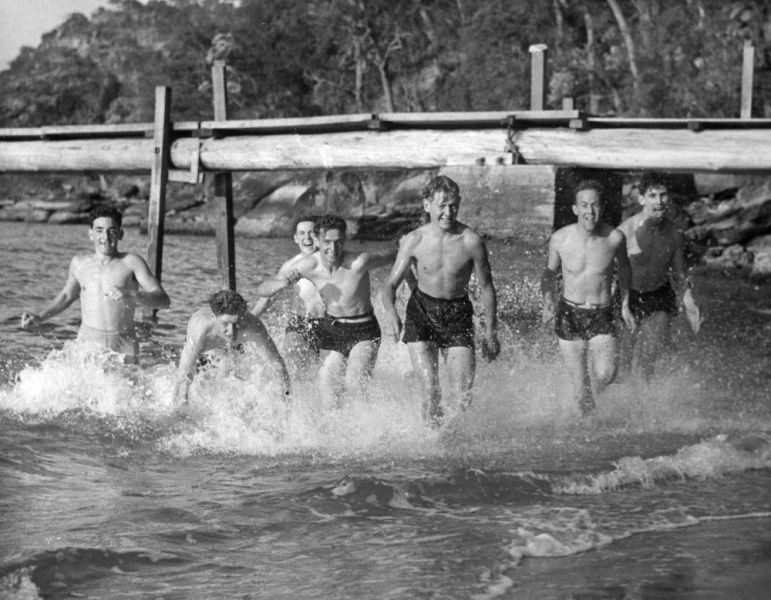
While in Broken Bay Recruit Seamen took advantage of the fine weather and went for a swim. Contributor(s): Argus (Melbourne, Vic.) ; Sydney Morning Herald Date(s): [ca. 1951] Argus Newspaper Collection of Photographs, State Library of Victoria. Accession no(s) H98.105/2288
Husky Young Salts
Seeing
them at work in the past few days-galloping to action stations on the first
harsh clamour of the alarm gong, straining at the oars of a whaler, and even
plugging away industriously at the monotonous but important shipboard job of
chipping and painting-has shown how well these youngsters have entered into the
spirit of the game.
In Broken Bay on Tuesday,
they lined the decks and cheered when an N.S. crew pulled a whaler raggedly but
enthusiastically across the finishing line three lengths clear of a crew of
Petty officers in a heat of the ship's regatta.
They are husky young salts
now, full of the jargon of the sea and the attitudes of sailormen. But only a
few weeks ago they were falling for the old gag of being sent to the coxswain
for the "key of both watches," or to the stores assistant to draw a "negative
jacket." [The Navy order "negative jackets" means jackets will not be
worn.]
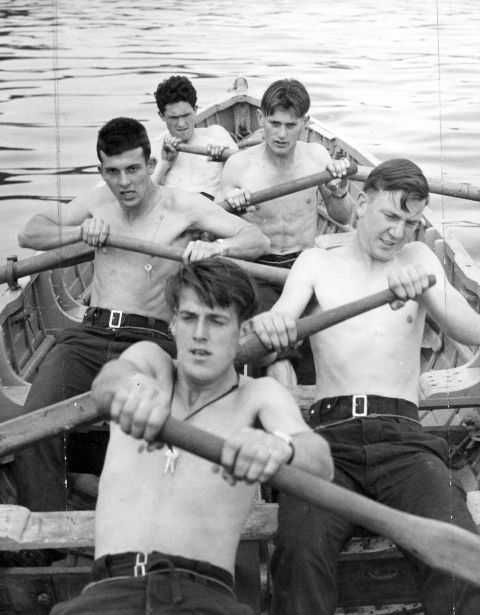 On second
day of cruise the Culgoa anchored in Broken Bay where a Ships Regatta was held.
Contributor(s): Argus (Melbourne, Vic.) ; Sydney Morning Herald. Date(s): [ca.
1951] Argus Newspaper Collection of Photographs, State Library of Victoria.
On second
day of cruise the Culgoa anchored in Broken Bay where a Ships Regatta was held.
Contributor(s): Argus (Melbourne, Vic.) ; Sydney Morning Herald. Date(s): [ca.
1951] Argus Newspaper Collection of Photographs, State Library of Victoria.
What do they think about the Navy now? Here
are the views of a few of them:
Gary Wright, of Hampton, Victoria: "I was in
the sea cadets for two years, and I've always been keen on the Navy. Now I'm in
it I think it's all right. I haven't made up my mind, though, whether I'd like
to stay in it permanently."
Alan Harding, of Bexley: "Sometimes you think you
would like to stay on and sometimes you think1 you wouldn't. But there's nothing
hard about the Navy. It's a good lurk."
Bruce Bowes, of
Brighton,
Victoria: "I was going to take it easy, this year anyhow. I won a
scholarship in commerce at Melbourne University and I intend to begin next year.
This spell with the Navy is a pleasant break. Most of the 'perms.'(permanent
service men) treat us very well, teach us all the tricks, and don't take
advantage of us. But what I don't like about the Navy is they never let you get
a job finished."
Johnny Holmes, of Newcastle: "The only reason I joined the
Navy was travel. I've made some bonzer' mates. The food's not bad, considering,
and the amenities are good. But the pay is bad. I'm losing 10 guineas a week
while I'm here."
Johnny is a £15-£16 a week labourer, and a preliminary
bantam weight boxer with 17 fights to his credit. Bruce is a student. Alan is a
precision grinder, and Gary is a shipping clerk.
Trainees Learn Navy's
Way. (1951, October 18). The Sydney Morning Herald (NSW : 1842 - 1954), p. 2.
Retrieved from http://nla.gov.au/nla.news-article18235594
This chant of great names closes with a Pittwater Regatta – and the flagships of 1952:
CAPTAIN of the corvette H.M.A.S. Wagga, which marked the start and finish of the yacht races at the Pittwater regatta yesterday-Lieut.-Commander C. CORNELIUS and MRS. CORNELIUS with two of the party they entertained aboard ship during the day, MR. IAN RITCHIE and MRS. RITCHIE (right). At Pittwater Regatta And Randwick Races. (1952, December 28). The Sunday Herald (Sydney, NSW : 1949 - 1953), p. 19. Retrieved from http://nla.gov.au/nla.news-article18504947
The Pittwater Regatta yesterday raised more than £100 for the Olympic Games Yachting Federation. The money will be used to enter Australian yachts in the Star and Dragon class events at the 1956 Melbourne Olympic Games Yesterday s Pittwater Regatta was one of the- most comprehensive yachting carnivals for several years. The programme included ricesfor nil classes of yachts-Dragons Stars VJ's VS's Moths and skiffs Dinghies and whalers from the regatta flagships HMAS Cootamundra and HMAS Wagga competed in special races for their class of boats. OLYMPIC YACHTS GET £100. (1952, December 28). The Sunday Herald (Sydney, NSW : 1949 - 1953), p. 8 Section: Sports Section. Retrieved from http://nla.gov.au/nla.news-article18504929
References:
The Voyage of Governor Phillip to Botany Bay with an Account of the Establishment of the Colonies of Port Jackson and Norfolk Island; compiled from Authentic Papers, which have been obtained from the several Departments to which are added the Journals of Lieuts. Shortland, Watts, Ball and Capt. Marshall with an Account of their New Discoveries, embellished with fifty five Copper Plates, the Maps and Charts taken from Actual Surveys, and the plans and views drawn on the spot, by Capt. Hunter, Lieuts. Shortland, Watts, Dawes, Bradley, Capt. Marshall, etc. London. Printed for John Stockdale, Piccadilly. 1789
2. National Service, 1951–59 – Fact sheet 163. Australian Archives Retrieved from http://www.naa.gov.au/collection/fact-sheets/fs163.aspx
Royal Navy and Royal Australian Navy Visits Pittwater and Broken Bay threads collected by A J Guesdon, 2013.
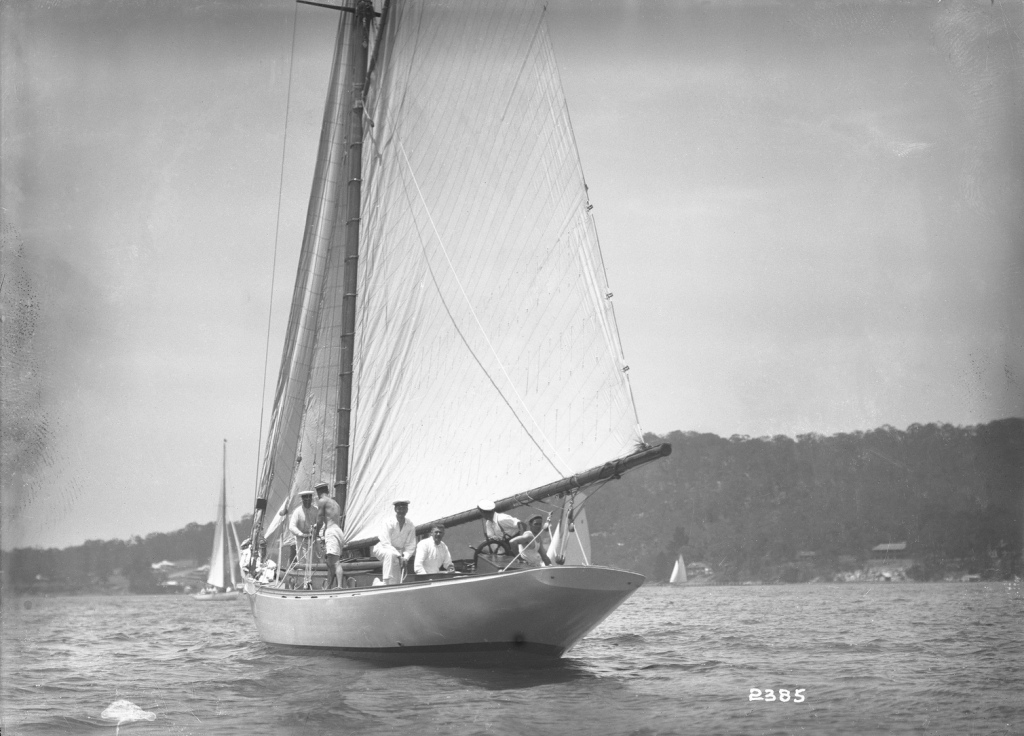
Sloop at Pittwater Regatta, Object number: 00011555, courtesy Australian National Maritime Musueum.